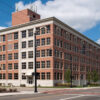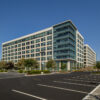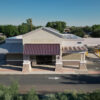There are simply too many parking spaces included in many commercial real estate development projects. There are currently 2 Billion Parking spaces in the United States Alone! Urban city planning is an essential aspect of modern urbanization, and it has a significant impact on the quality of life of the people who live in urban areas. One aspect of urban planning that has come under scrutiny in recent years is the number of parking spaces that are included in commercial real estate development projects. In many cases, there are simply too many parking spaces included in these projects, which has led to a range of negative outcomes. This article will explore the reasons why there are too many parking spaces in commercial real estate development, the consequences of this trend, and some potential solutions to the problem.
Reasons for Too Many Parking Spaces:
There are several reasons why developers may include too many parking spaces in commercial real estate development projects. One of the most common reasons is that developers often believe that more parking spaces will make their properties more attractive to potential tenants or buyers. This can be especially true for businesses that rely on customers who drive, such as retail stores or restaurants. However, this over-reliance on parking can lead to an oversupply of parking spaces that are often underutilized.
Another reason why there are too many parking spaces in commercial real estate development projects is that local zoning laws often require developers to provide a certain number of parking spaces per square foot of building space. These requirements are often based on outdated assumptions about the need for parking and may not reflect the actual transportation needs of the area.
Consequences of Too Many Parking Spaces:
There are several negative consequences of including too many parking spaces in commercial real estate development projects. One of the most significant consequences is that it can lead to increased traffic congestion and air pollution. When there are many parking spaces available, people are more likely to drive, even for short trips that could easily be made on foot, by bike, or on public transportation. This not only contributes to traffic congestion but also contributes to air pollution, which can have serious health consequences.
Another consequence of too many parking spaces is that it takes up valuable land that could be used for other purposes. Commercial real estate development projects often require large amounts of land, and dedicating a significant portion of that land to parking lots or garages can be a waste of resources. Additionally, these parking facilities can be eyesores that detract from the overall aesthetic of the city.
Solutions to Too Many Parking Spaces:
There are several potential solutions to the problem of too many parking spaces in commercial real estate development projects. One solution is to implement demand-based pricing for parking. This means that the cost of parking would be higher during peak periods and lower during off-peak periods. This would encourage people to use alternative forms of transportation during peak periods when parking is more expensive.
Another solution is to invest in public transportation options, such as buses, trains, and bike lanes. By making public transportation more accessible and attractive, cities can reduce the demand for parking spaces and encourage more sustainable modes of transportation.
Too many parking spaces in commercial real estate development projects is a problem that has significant negative consequences. By relying on outdated assumptions about transportation needs and local zoning laws that require a certain number of parking spaces, developers are encouraging car use and taking up valuable land that could be used for other purposes. However, there are potential solutions to this problem, such as demand-based pricing for parking and investment in public transportation. By implementing these solutions, cities can create more sustainable and livable urban environments for their residents while still accommodating the needs of businesses that rely on car traffic.
















